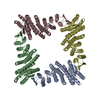+Search query
-Structure paper
| Title | De novo design of allosterically switchable protein assemblies. |
|---|---|
| Journal, issue, pages | Nature, Vol. 632, Issue 8026, Page 911-920, Year 2024 |
| Publish date | Aug 14, 2024 |
 Authors Authors | Arvind Pillai / Abbas Idris / Annika Philomin / Connor Weidle / Rebecca Skotheim / Philip J Y Leung / Adam Broerman / Cullen Demakis / Andrew J Borst / Florian Praetorius / David Baker /   |
| PubMed Abstract | Allosteric modulation of protein function, wherein the binding of an effector to a protein triggers conformational changes at distant functional sites, plays a central part in the control of ...Allosteric modulation of protein function, wherein the binding of an effector to a protein triggers conformational changes at distant functional sites, plays a central part in the control of metabolism and cell signalling. There has been considerable interest in designing allosteric systems, both to gain insight into the mechanisms underlying such 'action at a distance' modulation and to create synthetic proteins whose functions can be regulated by effectors. However, emulating the subtle conformational changes distributed across many residues, characteristic of natural allosteric proteins, is a significant challenge. Here, inspired by the classic Monod-Wyman-Changeux model of cooperativity, we investigate the de novo design of allostery through rigid-body coupling of peptide-switchable hinge modules to protein interfaces that direct the formation of alternative oligomeric states. We find that this approach can be used to generate a wide variety of allosterically switchable systems, including cyclic rings that incorporate or eject subunits in response to peptide binding and dihedral cages that undergo effector-induced disassembly. Size-exclusion chromatography, mass photometry and electron microscopy reveal that these designed allosteric protein assemblies closely resemble the design models in both the presence and absence of peptide effectors and can have ligand-binding cooperativity comparable to classic natural systems such as haemoglobin. Our results indicate that allostery can arise from global coupling of the energetics of protein substructures without optimized side-chain-side-chain allosteric communication pathways and provide a roadmap for generating allosterically triggerable delivery systems, protein nanomachines and cellular feedback control circuitry. |
 External links External links |  Nature / Nature /  PubMed:39143214 / PubMed:39143214 /  PubMed Central PubMed Central |
| Methods | EM (single particle) |
| Resolution | 4.32 - 4.55 Å |
| Structure data | EMDB-42442, PDB-8up1: EMDB-42491, PDB-8ure: EMDB-42542, PDB-8utm: |
| Source |
|
 Keywords Keywords | DE NOVO PROTEIN / Allosterically Switchable Protein / sr322 / closed state / de novo / allosterically switchable de novo protein / sr312 / effector peptide |
 Movie
Movie Controller
Controller Structure viewers
Structure viewers About Yorodumi Papers
About Yorodumi Papers









